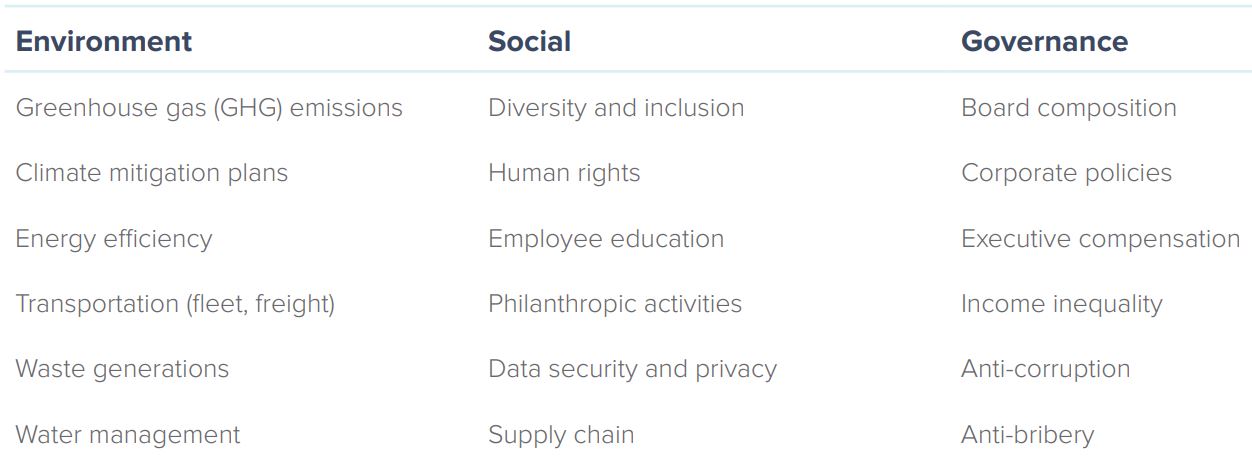Originally published in NAVEX Global’s Top 10 Risk & Compliance Trends for 2021 eBook. You can download the full eBook here.
Environmental, Social, and Governance (ESG) has become a key topic during board room discussions, elevating Corporate Social Responsibility (CSR) and Sustainability to the next level. It’s now imperative for companies to take action by incorporating and rolling out a well-structured ESG program that aligns with market expectations and investor interest in ESG information on investment opportunities.
The key to effective, scalable ESG management in the coming year will be to seek transparency, as well as the underlying information required to make informed business decisions.
In 2021, organizations will need to move beyond traditional corporate social responsibility reporting, and include ESG issues.
The increased interest at the board level has been driven by Bloomberg, Blackrock, the Sustainability Accounting Standards Board (SASB), and other investors and analysts. These groups have developed a common language and metrics that appeal to investors, the C-Suite, and other key stakeholders; SASB, for example, has developed over 70 industry-specific standards to align investors with corporate ESG reporting.
As a corporate leader, it is imperative to go beyond traditional CSR and Sustainability reporting. Stakeholders have much more awareness of concerns like diversity and inclusion, gender pay structure, donation programs, board composition, factory conditions, and how to mitigate climate risks.
Integrating ESG with the Rest of the Business
As ESG has evolved, increased integration across ESG, Sustainability, and other cross-functional teams is becoming more critical to the accuracy of the information. It takes more than one group to manage ESG efforts. Companies who align their ESG goals with business goals will have more long-term success as better information is collected by the appropriate professionals.
According to a 2019 report, Climate Finance Strategy 2018-2023, from the Hewlett Foundation:
“To put the world on the path to solving climate change, the current level of funding for climate-friendly activities must be tripled to at least $1.5 trillion annually. Fortunately, the multi-trillion-dollar capital sources needed for climate already reside in the current global financial system many times over.”
ESG reporting is typically considered collecting “non-financial” data which presents unique challenges as to what type of information to collect and where to identify where that data lives.
Investors Care about ESG Ratings For companies, ESG ratings have become a key driver for their Corporate Social Responsibility (CSR) and Sustainability initiatives.
The focus on ESG ratings is driven largely by investor demand for ESG data. Investment portfolios are now adding ESG information as part of their investment decision criteria and including it in newly created financial products to appeal to those who want their investments to align with their own values. Lacking ESG regulations, as of this writing, investors rely on ESG ratings to pressure companies to disclose corporate data, with the intention of standardizing criteria and providing that information to investors.
Ratings are simply intended to offer a high-level view into ESG performance, and disclosures around ESG concerns.
Discover: Automate and Simplify Your ESG Reporting
What are ESG Criteria? Think of ESG as another level of CSR or sustainability reporting, with the added criteria of increased Social and Governance metrics. The areas typically covered by the current SASB standard and other frameworks, meant to provide guidance for the information needed to meet the requirements set forth by these non-profit organizations.
The three elements of Environmental, Social, and Governance (ESG) provide insights into the sustainability and societal impact of an investment in a company. These elements are used to determine the health of the business today and future considerations.
The three key ESG categories consist of the following (see chart):

Why is ESG Reporting Important?
Many studies have been conducted over the past few years to illustrate the value of ESG to both investors and companies considering adoption. These studies have identified that assessing ESG practices can drive better valuations over time, drive down operating costs, identify potential risk to brand reputation - and allow companies to get ahead of potential issues that could cause business disruption, from product manufacturing to corporate performance.
What Your Company Can Do
Step 1: The first step to building an ESG program is to assess your current state, identify potential risks, and map metrics to corporate goals.
Step 2: Once you understand specifically what you’d like to accomplish, use a materiality analysis to engage with key internal stakeholders and establish priorities around strategy, goals, and metrics.
Step 3: Collect and consolidate information for reporting. While ESG is progressing forward, corporate ESG and Sustainability professionals must systematize responding to a wave of third-party ESG ratings and sustainability frameworks questionnaires. It will be increasingly important to consolidate auditable, accurate data that can be submitted through questionnaires and made public through Yahoo Finance, Bloomberg terminals, and other financial institutions.
Successful organizations may wish to prepare for a coming wave of consumer demands and investor interest in ESG information by creating a scalable ESG policy now.